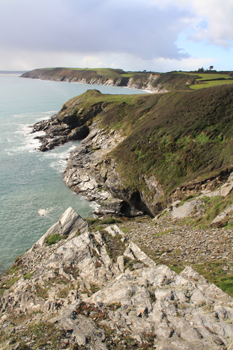 A month of above-average temperatures and many sunny days is giving our Roseland flora and fauna opportunities to prolong preparation for the winter ahead.
A month of above-average temperatures and many sunny days is giving our Roseland flora and fauna opportunities to prolong preparation for the winter ahead.
If you’re out walking the fields and coastal paths, you may have noticed that there are still butterflies looking for nectar, that is still widely available among late-flowering plants. Large stands of mature ivy are wafting scent abroad. Some garden plants too are showing well. This is good news for insects and of course good news for their predators, of which there are many.
We’ve been Choughed!
One predator that has lately been able to find resources here in the Roseland is the Cornish Chough (Pyrrhocorax pyrrhocorax). A pair of these birds has been seen several times on the cliffs over and around Killigerran, as well as at St Anthony and also at St Mawes Castle. Birders like myself are very excited about this arrival, as it may develop into permanent settlement, adding to the diversity of wonderful wildlife we have here.
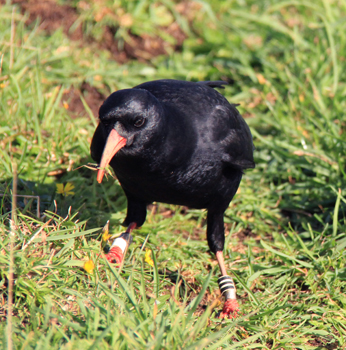
However, we already know the story of the two birds that arrived here, so breeding may not be likely. They are siblings, and came from a nest at Southerly Point on the Lizard, in the spring of this year. Their sex is unknown, and can only be reliably determined by measuring the width of the bill and the length of the tarsus. (Studies have shown that these measurements are larger on average in males than in females). Their story is a fascinating one. Their parents had been long established in the territory at Southerly Point.
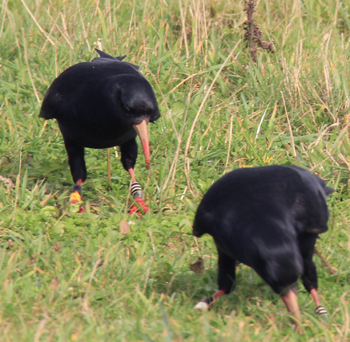
A new male arrived, determined to acquire the territory for himself. He fought the established male to the death and took over. The female continued to feed the young with the help of the new male until they were about 2 weeks old and then disappeared herself. The incoming male then continued to parent the young to fledging in early July. They left the Lizard, once fully independent, and arrived here more recently. They are both ringed. One bird has Black over white on the right leg, while the other has black over yellow.
Both birds have a black and white striped ring over a metal ring on the left leg. Unlike other corvids, they are surprisingly tolerant of human proximity, as long as observers keep calm and relaxed and look fairly disinterested.
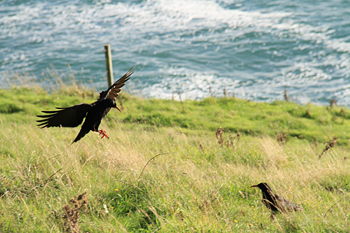
I have been able to get within a few feet of them this way and been delighted to watch their foraging and interaction with one another. Choughs like to poke their long red beaks into cow pats and soft soil in their search for bugs, grubs and other invertebrate prey. They also like flying insects, including grasshoppers, which they will give chase to.
Please keep a look out for these two young choughs, especially if you are out walking the cliff path between Towan and Porthbeor beaches. This, so far, has been the favoured area for foraging, as it has had livestock grazing it, which encourages a good mix of insect life, as well as variable sward; The RSPB Cornish Chough Project wants to know about every sighting. If you do see them, please email Claire Mucklow, who is the RSPB Choughs Project Officer.
Seal of approval
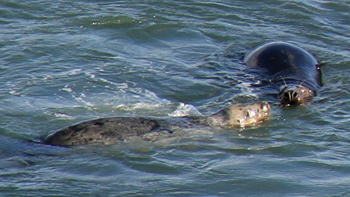 Something else to look out for when walking the coast paths is the presence of seals, hauled out on beaches or rocks or generally lolling about in the shallows. The regular haul-out near Towan beach has had several visitors recently, including four juveniles and even a weaner pup. The juveniles are very boistrous, appearing to have much leisure time for romping around in the water together, whilst the more mature animals chill out on the beach. It’s good to think that life for other sentient beings is not all about the struggle to find the next meal, but there is good time for rest and leisure too.
Something else to look out for when walking the coast paths is the presence of seals, hauled out on beaches or rocks or generally lolling about in the shallows. The regular haul-out near Towan beach has had several visitors recently, including four juveniles and even a weaner pup. The juveniles are very boistrous, appearing to have much leisure time for romping around in the water together, whilst the more mature animals chill out on the beach. It’s good to think that life for other sentient beings is not all about the struggle to find the next meal, but there is good time for rest and leisure too.
 As well as grey seals, a common seal has been seen in the water around the same stretch of coast. This individual may have visited in previous years. You are unlikely to see it hauled out with the adult greys, compared with whom it is smaller, as well as having a somewhat shorter and cute-looking snout.
As well as grey seals, a common seal has been seen in the water around the same stretch of coast. This individual may have visited in previous years. You are unlikely to see it hauled out with the adult greys, compared with whom it is smaller, as well as having a somewhat shorter and cute-looking snout.
References
http://www.rspb.org.uk/ourwork/projects/details/223656-cornwall-chough-project
https://www.rspb.org.uk/wildlife/birdguide/name/c/chough/index.aspx
Blanco, G., Tella, J.L., & Torre, I. (1996) Age and sex determination of monomorphic non-breeding choughs: a long-term study. Journal of Field Ornithology, 67(3), 428-433.
All Photography by Sarah E Vandome
Enjoy more Roseland wildlife and landscapes – visit my Heart of Roseland Facebook feature:
